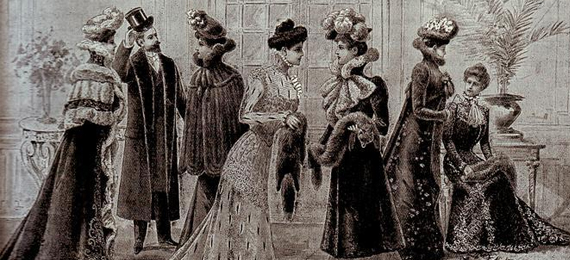
Overview :
The 1900s saw significant fashion shifts and distinctive styles, with the Edwardian era featuring women’s high collars, long skirts, and corsets. World War I led to shorter skirts and looser clothing, while the 1920s saw the Roaring Twenties, featuring women’s liberation and the iconic flapper style. The 1930s saw more feminine and glamorous styles, while the 1940s saw wartime austerity and utilitarian designs. The 1960s saw a youthful, mod fashion revolution, and the 1970s saw a bohemian and eclectic style.
1900 to 1910 Fashion
The 1900s is when technology started developing slowly so fashion in the 1900s was also developing. But it mostly remained the same continuing the fashion followed in the previous decade. The period of the 1900s is known as ‘the age of the hourglass’. The 1900’s fashion was known for its hourglass figure. This is when the fashion game started to level up.
1900 Women’s Fashion
- In the early 1900s, women’s fashion underwent significant changes, reflecting the transition from the Victorian era to the Edwardian era. The hourglass figure was still highly valued, with emphasis on a small waist and a full bust and hips. Here is an overview of women’s fashion during the 1900s:
- Silhouette: The hourglass silhouette was achieved by wearing corsets, which cinched the waist tightly and accentuated the bust and hips. This created an “S” curve shape, with a protruding bust and posterior.
- Bodices and Blouses: Women wore high-necked blouses and bodices, often with long sleeves. Lace, ruffles, and frills were common decorative elements. Collars were often stiff and detachable, allowing for variation in style.
- Skirts: Skirts were long and full, reaching the ankle. They were typically worn with petticoats to create volume. As the decade progressed, skirts began to have a slightly slimmer silhouette, transitioning from the bell shape of the Victorian era.
- Fabrics and Colors: Fabrics used included cotton, silk, satin, and lace. Pastel colors and delicate floral patterns were popular, reflecting the feminine aesthetic of the era. Darker colors were reserved for more formal or evening wear.
- Hats and Accessories: Women wore hats as a staple accessory, often decorated with feathers, flowers, or ribbons. Gloves were also an essential part of a lady’s attire, with different lengths worn for various occasions. Parasols or umbrellas were used for sun protection.
- Hairstyles: In the early 1900s, women often wore their hair in Gibson Girl-inspired updos or elaborate styles with curls and waves. As the decade progressed, hairstyles became simpler, with the introduction of the “pompadour” and later the “Marcel wave.”
- Shoes: Shoes had a low heel and a rounded or pointed toe. They were often made of leather and featured straps or laces.
It’s important to note that fashion evolved throughout the decade, and there were variations in styles depending on social class and geographic location.
1. Picture Hats Are Also Known as Gainsborough Hats.
- A. True
- B. False
omen’s fashion was all about embellishments, laces, embroideries, bows, feathers, etc. The more stuff you had on your hats and dresses the more high class and modern you were considered.
Men’s Fashion
In the early 1900s, men’s fashion underwent notable changes, transitioning from the formal Victorian era to a more relaxed and practical style during the Edwardian period. Here is an overview of men’s fashion during the 1900s:
- Suits: Suits were the standard attire for men, consisting of three main components: a jacket, trousers, and a waistcoat (vest). Suits were typically made of wool or tweed fabrics, reflecting durability and practicality.
- Jackets: Jackets had a tailored fit with structured shoulders and a defined waist. They featured a variety of styles, including single-breasted or double-breasted options. Lapels were generally notched or peaked.
- Trousers: Trousers were high-waisted and often pleated, providing a loose and comfortable fit. They were typically cuffed at the bottom and worn with suspenders (braces) since belts were not commonly used.
- Shirts: Shirts were usually made of cotton or linen and had high, stiff collars. Wing collars and detachable collars were popular, especially for more formal occasions. Shirts often featured studs or cufflinks for closure.
- Neckties: Neckties were an essential accessory, tied in a variety of knots such as the four-in-hand or the Ascot. Ties were typically long and narrow, often made of silk or other luxurious fabrics.
- Hats: Men commonly wore hats, including bowler hats, fedoras, and flat caps. Hats were an integral part of men’s fashion and provided both style and practicality.
- Outerwear: Overcoats and topcoats were worn during colder months, typically made of heavy fabrics like wool or tweed.
- Shoes: Men’s footwear consisted of lace-up leather shoes with rounded or pointed toes. Boots were also commonly worn, particularly for outdoor activities.
- Accessories: Other accessories included pocket watches, walking sticks, and gloves, which were often worn for formal occasions or during cold weather.
Throughout the early 1900s, men’s fashion evolved, influenced by social, economic, and cultural changes.
Children’s Fashion
In the 1900s most children were dressed up like adults except they were comparatively simpler. Young girls wore knee-length dresses that were designed with laces and embroideries all over. For more informal occasions, they wore pinafores with blouses. Additionally, they wore shoes with stockings, boots, gloves, etc. They normally had curly wavy hair decorated with lots of ribbons. Boys, on the other hand, followed almost a similar fashion of wearing stocking and shoes but with Russian blouses along with shorts or knickers. Sailor suits and tunics were also famous and worn by almost all the young boys. Both boys and girls wore light-colored dresses as they indicated the wealth of their families.